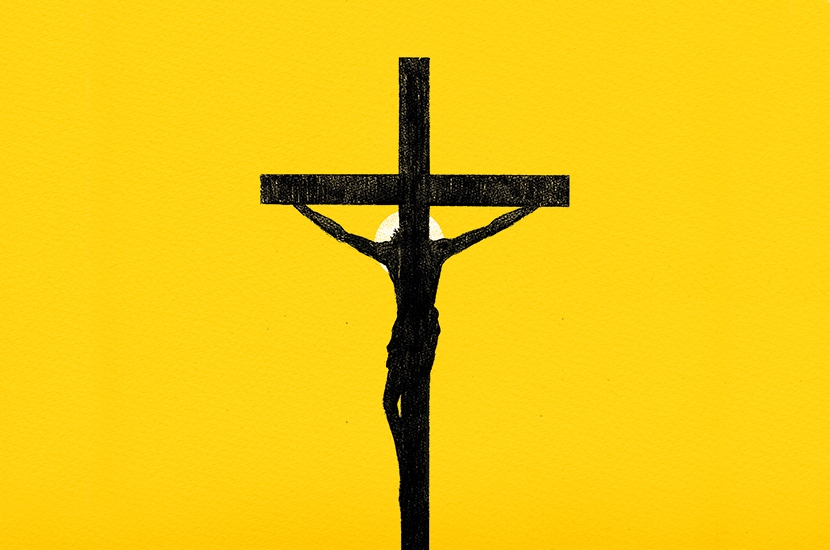On Saturday evening, Christians will prepare for an Easter unlike any other. With every church in Britain closed, from St Paul’s Cathedral to the meanest country chapel, Anglican worshippers will be directed to a website where lay leaders, priests and bishops will hold a ‘virtual vigil’ ending at dawn on Easter Sunday. In Westminster Cathedral, the mother church of Catholics in England and Wales, a deacon will sing the great Easter proclamation known as the Exsultet. But this year, when the final syllable dies away, he will look out into the nave and see row upon row of vacant seats. It’s faith, but without the faithful.
It’s happening the world over. This week Jewish families were forced to celebrate the Passover Seder without guests for the first time. Regent’s Park mosque has canceled all major events and advised Muslims to pray at home. For those who think it’s difficult enough to keep faith in a secular country like Britain, the fear isn’t so much the lockdown as what comes after. Will people get out of the habit of worship? Might faith — already fast declining in Britain — enter a downhill slump?
Christian thinkers are split into two broad camps: those who believe the crisis will lead to a religious revival and those who think it will hasten the demise of organized religion. Resurgence or ruination, which one will it be?
The case for resurgence could be summed up by the phrase ‘There are no atheists in foxholes’. No one’s sure who said it first, but it could date back to a sermon by a chaplain during the Battle of Bataan in 1942. That would be fitting, because World War Two is central to the reasoning of those who foresee a Christian renaissance. The COVID-19 outbreak, they say, is the western world’s first experience of mass death since 1945. The following years saw a boom in religiosity. The 1950s was, in some respects, a golden age of American Christianity. Mainline Protestantism flourished, while the Catholic televangelist Fulton Sheen held audiences spellbound as he wafted his cape. In 1954, Congress added ‘under God’ to the Pledge of Allegiance.
But the argument for revival doesn’t rest solely on a historical analogy. It also cites growing evidence that something is stirring in the souls of millions presently under lockdown. The number of people searching for the word ‘prayer’ on Google ‘skyrocketed’ last month, doubling with every 80,000 new registered cases of coronavirus, according to a University of Copenhagen study. A Pew poll found that 55 percent of Americans have prayed for an end to the pandemic. And no, it’s not only the Bible Belt: researchers reported that 15 percent of those who ‘seldom or never pray’ and 24 percent of those who do not belong to any religion have prayed about the virus.
With worshippers confined to their homes, websites that livestream church services are reporting record figures. Pray.com,which describes itself as ‘the world’s #1 prayer app and website’, is racking up new subscribers (and revenue). In England, meanwhile, more than half a million Catholics took part in a ceremony rededicating the country to the Blessed Virgin Mary in late March. So many people logged on to the main website that it crashed. Traffic promptly brought down a second site too.
But what if the coronavirus outbreak is not, in fact, a catalyst for spiritual renewal? What if, after the lockdown is lifted, the pews remain empty? Some sociologists believe that coronavirus is a dire threat to western Christianity. They predict that the disease will speed up the already fast drop in churchgoing. As donations fall, church schools, hospitals, homeless shelters, parishes and even cathedrals will struggle to survive.
The decline in religious affiliation is arguably the most striking demographic change to occur in Britain in the past few years save for immigration — the latter only partially offsetting the former. The British Social Attitudes survey found that the number of Anglicans halved between 1983 and 2014. Between 2001 and 2011, the number of people identifying as Christian in the UK fell by 4.1 million, despite the arrival of 1.2 million adherents from Eastern Europe and Africa. If UK-born Christians continue to disappear at that pace, hardly any will remain by 2067.
Stephen Bullivant, whose book Mass Exodus studied Catholic attrition in Britain and America, offers three reasons why he believes churches will shrink after the pandemic. First, he says, churchgoers (both lay and clergy) tend to be elderly and therefore more likely to die of coronavirus. Second, many churches rely on a steady influx of immigrants. With the world in lockdown, that supply has, at least temporarily, dried up. Third, churchgoing is a habit, and once that habit is broken it is hard to take it up again.
For a ‘decent minority’ of people, Bullivant says, ‘a period of weeks or months when they can’t go to Mass, might easily be the “nudge” required to stop altogether. This will be especially true if, as seems likely, we will have a long period where people can go to church again, but when being part of a large gathering is still widely viewed, and possibly officially cautioned against, as an “unnecessary risk”.’
Many who have attended services dutifully their whole lives feel aggrieved by the speed with which bishops agreed first to prohibit public liturgies and then to shut churches. For Catholics, this is particularly wrenching, as the Church teaches that it’s a grave sin to miss Sunday Mass. Now, for the first time in living memory, the bishops have assured believers that it’s permissible — virtuous even — to spend the day at home. A cynic would argue that the Sunday Mass obligation has been a major retention tool for the Church. It may help explain why Catholicism is declining at a slower rate than Anglicanism in Britain. But after the coronavirus crisis, some Catholics may feel less bound by a requirement that was dispensed with so abruptly.
Live-streamed services, meanwhile, are proving a poor substitute for the real thing. They lack the vital communal dimension of worship and even the most pious Christian will admit they are, at times, excruciatingly dull. At church, you can fill the longueurs by gazing across the pews, but laggy live-streams only accentuate the tedium. Worst of all, believers are unable to receive the Eucharist.
The lockdown is testing believers of all stripes. Defiance of prevailing norms is, after all, a part of many religions. Consider Egypt’s Copts: in recent years they have risked their lives to attend services. Now, with a night-time curfew imposed by the authorities, they may struggle to attend any Easter celebrations. Or think of Orthodox Jews who wear skullcaps on the street despite the risk of attack. Now they are unable to recite cherished prayers because they cannot form a minyan: the quorum of ten men required for public worship in Judaism. Or spare a thought for Muslims in Sri Lanka, where Covid-19 victims are being cremated, in violation of Islamic tradition.
Brazil’s President Jair Bolsonaro, who came to power with Evangelical support, designated last Sunday as a national day of prayer and fasting for an end to the pandemic. When state governors tried to ban religious gatherings, Bolsonaro overruled them and issued a decree exempting churches.
A few years ago an Anglican church in York ordered some Easter banners proclaiming that ‘Christ is risen’. They came back from the printers with a missing ‘T’.
‘Chris is risen’ is not, in fact, an entirely misleading summary of Christianity and the centrality of Easter to the faith. Christians believe not only in the resurrection of Christ, but also in the ‘general resurrection’ when people called Chris, and Caroline, and Joe, and Jade, will rise from the dead.
This notion has long struck people as absurd. ‘No doctrine of the Christian faith is so vehemently and so obstinately opposed as the doctrine of the resurrection of the flesh,’ said St Augustine in the 5th century. But the Church has never ceased to proclaim it.
If you’re wondering what the general resurrection might look like. I recommend viewing ‘The Resurrection, Cookham’ on the Tate’s website. It’s a gigantic painting, 9ft high and 18ft long, depicting an English churchyard. The graves are unsealed: their occupants are peering out of them, climbing out of the ground or lying back on their tombs as if they are sunbathing. The figures were contemporaries of the artist, Stanley Spencer, and the scene was set in the village of Cookham where he grew up. While Spencer intended the painting to convey ‘the possibilities of heaven in this life’, it is also a joyously down-to-earth expression of ‘the resurrection of the dead’ proclaimed in the Nicene Creed.
Spencer’s tranquil vision is all the more remarkable given that he had spent two and a half years on the front line in Macedonia during the first world war, which claimed the life of his elder brother Sydney.
Could 21st-century secular Britons come to believe in something as astonishing as the Resurrection? As I write, there are 70,797 reported deaths from COVID-19 worldwide. Each one of those is an irreplaceable loss, but we’re still a long way off World War Two’s estimated death toll of 56 million. Will the pandemic’s effects be so profound that they change the West’s prevailing view of mortality? It’s hard to believe that.
The case for ruination is, unfortunately, more persuasive than the one for resurgence. The virus’s impact on religious practice is overwhelmingly negative.
But history teaches us that it’s foolish to write off religion. In The Everlasting Man, G.K. Chesterton noted how shocking it was that the Age of Enlightenment was followed by an explosion of religiosity in the form of the Oxford Movement and the French Catholic revival. It was, he said, as confounding to most people as ‘a river turning backwards from the sea and trying to climb back into the mountains’. Christian history, Chesterton argued, is not linear but cyclical. The Church seems all but exhausted, then bursts to life again. Chesterton called these historical setbacks the ‘five deaths of the faith’. ‘At least five times,’ he wrote, ‘with the Arian and the Albigensian, with the Humanist sceptic, after Voltaire and after Darwin, the Faith has to all appearance gone to the dogs. In each of these five cases it was the dog that died.’
For decades now, observers have declared that Christianity is dying. Rampant secularization coupled with coronavirus will only seem to bring forward the obsequies. But Christianity began amid defeat and despair. And, if Chesterton is right, this won’t be the end, rather a new beginning.
This article was originally published in
The Spectator’s UK magazine. Subscribe to the US edition here.


















